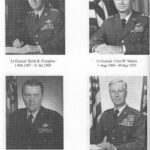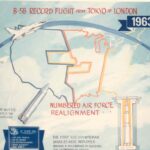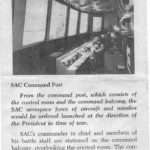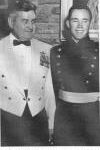SAC History
The Continental Air Forces, established December 13, 1944, coordinated the activities of its four numbered air forces (First, Second, Third, and Fourth) in the United States. Strategic bombardment operations during World War II, however, had shown the need for a major command devoted exclusively to strategic, long-range air combat operations. The Continental Command was renamed Strategic Air Command on March 21, 1946, and was given the mission of strategic operations. On June 1, 1992, a result of the diminishing danger of massive nuclear warfare and the disappearance of a meaningful distinction between strategic and tactical missions, Strategic Air Command was deactivated and its assets were assigned to the newly created Air Combat and Air Mobility Commands. |
COMMANDERS IN CHIEF STRATEGIC AIR COMMAND
(click name for bio and it will open in another window)
| Name | From | To |
| Gen George C. Kenney | 21 Mar 1946 | 18 Oct 1948 |
| Gen Gurtis E. Lemay | 19 Oct 1948 | 30 Jun 1957 |
| Gen Thomas S. Power | 1 July 1957 | 30 Nov 1964 |
| Gen John D. Ryan | 1 Dec 1964 | 31 Jan 1967 |
| Gen Joseph J. Nazzaro | 1 Feb 1967 | 28 July 1968 |
| Gen Bruce K. Holloway | 29 July 1968 | 30 April 1972 |
| Gen John C. Meyer | 1 May 1972 | 31 July 1974 |
| Gen Russell E. Dougherty | 1 Aug 1974 | 21 July 1977 |
| Gen Richard H. Ellis | 1 Aug 1977 | 31 July 1981 |
| Gen Bennie L. Davis | 1 Aug 1981 | 31 July 1985 |
| Gen Larry D. Welch | 1 Aug 1985 | 30 June 1986 |
| Gen John T. Chain | 1 July 1986 | 31 Jan 1991 |
| Gen George L. Butler | 1 Feb 1991 | 1 June 1992 |
SAC Command and Staff


CINCSAC Listing

Vice CINCSAC Listing

Chief of Staff Listing
History of The Strategic Air Command Crest
“SAC PRESS KIT” 1972

General Bruce K. Holloway
Commander in Chief, Strategic Air Command -- General Bruce K. Holloway.

General George C. Kenney
FIRST COMMANDER ARRIVES... After successflly commanding the Pacific air campaign in World War II, General George C. Kenney was picked to become the first commander of SAC. His job - build a strategic force capable of conducting long-range bombardment operations anywhere in the world.

General Curtis E. LeMay
THE LIVING LEGEND... A tough, cigar-chewing taskmaster, General Curtis E. LeMay commanded the Strategic Air Command for nine years-1948 to 1957. For additional information about Genral Lemay, click on the following link http://www.afa.org/magazine/march1998/0398lemay.asp

General Curtis E. LeMay
SALUTE TO BUENOS AIRES... Demonstrating the versatility and strength of SAC's new high-altitude KC-135 tanker, General Curtis E. LeMay, Air Force Vice Chief of Staff and former SAC Commander made history in 1957 in a 6,500 mile non-stop unrefueled flight to Argentina. Originating from Westover AFB, Mass. on November 11th, the return flight three days later set a new speed record of 11 hours and 5 minutes. Standing at attention at National Airport, Washington D.C. upon completion of the record flight are (l to r) Hon. Robert Murphy, Deputy Under Secretary of State; Hon. James A. Douglas, Secretary of the Air Force; General Thomas D. White, Chief of Staff USAF; General LeMay; Capt.Charles A. Gandy, pilot; and Capt. Howard Dries.

General Thomas E. Power
GLOBAL COMMANDERS...At the end of the fifties, SAC's worldwide capability under General Thomas E. Power posed a credible deterrent to the possibility of Soviet aggression. Conferring at Headquarters, Strategic Air Command at Offutt Air Force Base, Nebraska, are (l to r) Lt. Gen. Archie J. Old, Commander, 15th Air Force; Lt. Gen. J.P. McConnell, Commander, 2nd Air Force and later Air Force Chief of Staff; General Power; and Lt. Gen. Walter C. Sweeney, Jr., Commander 8th Air Force.

Vice President Hubert H. Humphrey
VICE PRESIDENT BRIEFED... In May 1965, Vice President Hubert H. Humphrey listened attentively as officials briefed him on the capabilities and posture of the Strategic Air Command. Prior to his visit hosted by SAC Commander in Chief, General John D. Ryan ,(r) the United States had test launched its first ICBM MINUTEMAN missile from an operational site at Ellsworth AFB, S.D. A month later, June 6, 1965, SAC entered the SE Asia conflict with its first B-52 raid over Vietnam.

SAC BOMBERS IN KOREA
SAC BOMBERS IN KOREA... Under the operational direction of the Far East Air Forces Bomber Command in Korea from 1950 to 1953, SACB-29s flew 21, 328 combat sorties and delivered 167,000 tons of bombs on Communist targets. Here in August 1952, Capt. Reuben T. Long, Jr. (r) bombardier who aimed the 252,066th pound of high explosives, explains the fusing device on a 4,000 pound bomb to radarman 1st Lt. Glen T. MacClure. Their B-29, "Sick Em" flew 60 combat missions through flak and fighter attacks without an abort.

This is the heading
B-52 AROUND THE WORLD FLIGHT... Three B-52 bombers circled the globe on January 16-18, 1957 in the historic peacetime Operation "Power Flight" demonstrating SAC's capability of striking anywhere on the face of the earth. Departing form Castle AFT, California, the flight covered 24, 325 miles in 45 hours and 19 minutes and was led by Major General Archie Old. Fr., Commander of the Fifteenth Air Force. The only comparable flight up to that time occurred in 1949 when the "Lucky Lady II" B-50 mad the first non-stop round-the-world flight in 94 hours.

The Martin MB-2
EARLY BOMBER... Never used in combat, the Martin MB-2 played a major role in the development of airpower. The MB-2 was designed as a night bomber and thus sacrificed the speed and maneuverability of an early model MB-1 for a greater bomb load. This was the aircraft used by Brig. Gen. Billy Mitchell when he succeeded in sinking the "war prize" German battleship Ostfriesland in testing during July 1921.

WATERTIGHT BOMBER
WATERTIGHT BOMBER... A new generation in strategic bombing evolved with the production of the Martin B-10 bomber. It featured an enclosed cockpit, a power-operated turret, retractable landing gear. newly designed engine cowling, and had a top speed of 212 mph. Because of its reliability, Lt. Col. H.H. "Hap" Arnold led a flight of 10 B-10s in 1934 from Washington DC to Fairbanks, Alaska, a round trip of 8,920 miles. Because of the watertight wings and stabilizers, one of the planes was recovered after ditching in Cook Inlet and made the return trip.

MITCHELL BOMBER
MITCHELL BOMBER"... Named in memory of Brig. Gen.William "Billy" Mitchell, the North American B-25 proved to be one of the most outstanding aircraft of WWII. Although flown on every front, the B-25 gained its fame as the plane flown from the aircraft carrier USS Hornet by Lt. Col. Jimmy Doolittle and his Tokyo raiders against the Japanese mainland in April 1942. The B-25G housed a nine-foot 75mm cannon and four .50 caliber machineguns in the nose, two forward firing .50s on each side of the fuselage, twin .50s in the tail and a .50 on each of the side blisters. The last B-25, a staff transport model. was retired from the Air Force in 1960.

This is the heading
FIRST SAC JET... Strategic Air Command began operations in 1946 with 600 aircraft, of which only 3 were jet powered - the P-80"SHOOTING STAR" fighter developed during the latter part of WWII. Later modified with a longer fuselage and extended canopy, it was re-designated the T-33 and served as the USAF's standard jet trainer with production continuing until 1959. On Nov. 8, 1950 an F-80 destroyed a Russian built MIG-15 over Korea in what is believed to be the firs conclusive air combat between jet fighters.

FLYING FORTRESS
FLYING FORTRESS... The B-17 FLYING FORTRESS has often been referred to as "the plane that carried the war (WWII) to the enemy'homeland." Following the attack on the Philippines in 1941, B-17s flying from Del Monte Field became the first US aircraft in offensive action as they attacked Japanese shipping of the coast. Also, in Europe, the B-17s were used for the first US attack against Germany on Jan 27, 1943. More than 12,000 were accepted during WWII.

LOOK ALIKE BOMBERS
LOOK ALIKE BOMBERS... A refueling version of the B-29(r) hooks up with a B-50 SUPERFORTRESS bomber which entered the SAC inventory in 1948 to replace the older B-29 bombers. The Atomic Age was opened by the B-29 "Enola Gay" which dropped the first atomic bomb on Hiroshima to end World War II in the Pacific. After the war, 101 B-29s were assembled in a maximum effort simulated "raid" over New York City shortly after SAC was organized. After retirement of the bomber versions in 1954, B-50s became efficient high altitude refueling aircraft which could refuel three planes at once.

THE PEACEMAKER
THE PEACEMAKER... Helping to deter general war for more than 10 years, the B-36 bomber holds a notable place in SAC history as the largest combat aircraft to reach full production status without ever flying a combat mission. Introduced in 1949, the B-36 D version featured four turbojets under each wing in addition to six propeller engines giving the 230 foot long bomber a speed of 435 mph, a ceiling of 45,000 feet, an increased bomb load of 84.000 pounds and a range of 10,000 miles. On Feb 12, 1959, the Strategic Air Command retired the last B-36 to become an all-jet bomber force.

B-47 STRATOJET
B-47 STRATOJET... The mainstay of SAC's deterrent strength for 15 years, the Boeing built B-47s were the first swept-wing jet bombers built in quantity for any air force. First flown in 1947, the six engine aircraft served in SAC until 1966. In 1954, three B-47s flew from March AFB. California to Yokota, Japan in 14 hours 12 minutes setting a new average speed record of 540 mph. Led by Maj. Gen. W.D. Sweeney, 15th Air Force Commander, the deployment marked the first appearance of SAC B-47s in the Far East and the longest point-to-point nonstop B-47 flight to that date. The last STRATOJET delivered to SAC in February 1957 brought the total in service to 1800.

RECORD BREAKING "HUSTLER"
RECORD BREAKING "HUSTLER"... The B-58, the world's first production supersonic bomber, was one of SAC's mightiest deterrents for more than nine years. First accepted into the inventory in 1960, it broke many world speed records including New York to Paris in 3 hours, 19 minutes--one tenth the time taken by Lindburgh on his famous solo flight. Because of the addition of the FB-111, advances in the MINUTEMAN and POLARIS missile systems, and life extension of the B-52, the B-58 fleet went into honorable retirement in January 1970.

HIGH ALTITUDE REFUELING
HIGH ALTITUDE REFUELING... High above the clouds, a Strategic Air Command B-52 heavy bomber is refueled by a KC-135 STRATOTANKER. Like the Western Marshal, the B-52 wears its sidearms of the Hound Dog air to ground missiles which extend the striking range by more than 500 miles.

CONVENTIONAL BOMBING
CONVENTIONAL BOMBING... This camouflaged B-52 STRATOFORTRESS releases its 60,000 - pound load of "iron bombs" on targets in Vietnam. Each B-52 can carry up to eighty-four 500 pound bombs or forty-two 750 - pound bombs internally and twenty-four 750 - pound bombs externally on racks under the wings.

This is the heading
SAC, SINGLE MANGER OF THE U.S. AIR FORCE TANKER FLEET...The Strategic Air Command, with its KC-135 jet STRATOTANKERS, provides all air-to-air refueling for the U.S. Air Force, worldwide. One of these tankers is shown refueling a flight of F-4C PHANTOM fighters in Southeast Asia. The fighters belong to the Tactical Air Command.

SR-71
SR-71... The new United States Air Force SR-71 aircraft,assigned to Strategic Air Command, provides SAC with the world's most advanced strategic reconnaissance plane. The SR-71 flies at more than three times the speed of sound and operates at altitudes in excess of 80,000 feet.

This is the heading
FB-111 STRATEGIC BOMBER... The FB-111 is a variation of the F-111 Tactical Fighter. The wing of the FB-111 can be varied in flight to provide stable, efficient performance throughout the plane's speed spectrum -- from slow approach speeds to more than twice the speed of sound. They will supplement the SAC B-52 fleet and will carry either nuclear or conventional weapons.

B-1
B-1... Taking advantage of the advances made in airframe, engine, and avionics during the past 20 years, the B-1 strategic bomber will be a valuable addition to the U.S. Strategic deterrent force. In Comparison to the B-52, the new bomber will penetrate enemy defenses at significantly higher speeds and lower altitudes, carry greater payloads, and be capable of more rapid launch. It will also be able to carry nearly any weapon in the Air Force inventory, plus advanced weapons which are being studied or developed.

TITAN II
TITAN II... Heavyweight of SAC's large ICBM force, TITAN II is launched directly from its underground storage silo. Smoke and flame shoot from the exhaust vents as the missile starts on its intercontinental - range flight. The TITAN II plays a vital role in the U.S. Air Force deterrent force.

MINUTEMAN
MINUTEMAN... This three-stage solid-fuel ICBM is silo-stored and ready for almost instantaneous launch by a SAC Combat Missile Crew. The typical "smoke ring," present at each MINUTEMAN launch, appears at the top of the photo. Intercontinental in range, MINUTEMAN plays a vital role in the U.S. Air Force deterrent force.

HQ STRATEGIC AIR COMMAND
HQ STRATEGIC AIR COMMAND... Command and control of the world-wide SAC organization is exercised from headquarters near Omaha,Neb. The MINUTEMAN missile "Shell" mounted for permanent display in front of the headquarters is symbolic of the missile force in the Command today.

UNDERGROUND COMMAND POST
UNDERGROUND COMMAND POST... Shown in the heart of SAC's command and control system located deep beneath Headquarters SAC.Senior operations personnel are in continuous contact with all SAC missile and bomber bases and with national civil and military centers. The SAC commander in chief can be contacted within seconds. SAC's famous 'red telephone' is located on the communications panel, center. Graphic and pictorial information is shown on the large screens at left.

ALERT
ALERT... Members of a SAC B-52 combat crew race for their always ready-and-waiting B-52 heavy bomber. Forty per cent of the SAC bomber and tanker force is on continuous ground alert, ready to be en-route to a target within the warning time provided by the ballistic missile early warning system. One of the bomber's two HOUND DOG missiles is shown in the foreground.
































































































